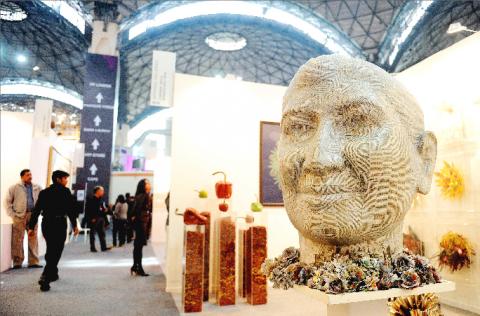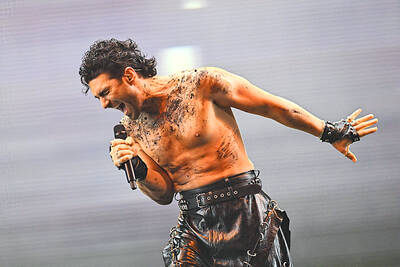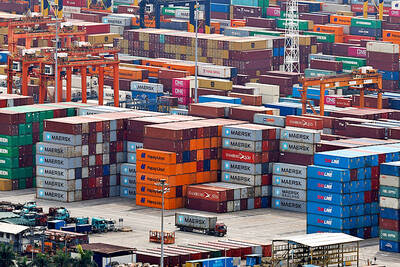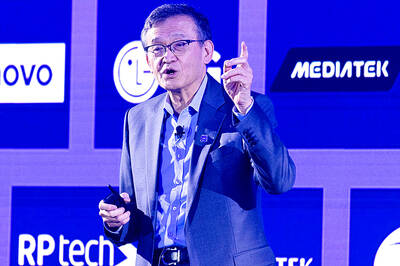India’s biggest art fair opened on Friday, pulling in dozens of foreign galleries seeking to tap a new breed of buyers in one of the world’s fastest-growing economies.
Now in its third edition, the annual Indian Art Summit has expanded sharply in both size and prominence, with 84 galleries taking part this year compared with 55 last time.
As well as offering rare global exposure for Indian artists, it also provides an exploratory platform for overseas dealers who feel India’s booming economy is minting a sizeable pool of wealthy buyers interested in international art.

Photo: AFP
The number of participating foreign galleries has doubled from last year to 34, with exhibitors from France, Germany, Canada, the US, Singapore and Japan.
“From the start, our objective was to create a window into the Indian art market,” the event’s director Neha Kirpal said. “We wanted to facilitate the growth of Indian art and its market within India, and to create a consolidated platform of Indian art for the world outside.”
The lack of both a vibrant museum culture and private funding for art events means public awareness, particularly of contemporary art, is still very much in its infancy in India.
However, overseas interest, following a general slump in prices in 2009, is regaining momentum — albeit with a strong focus on well-established artists.
Last year, a 1983 painting, Saurashtra, by Syed Haider Raza, sold for about £2.4 million (US$3.8 million) at Christie’s in London, setting a record for a modern Indian work.
“Serious collectors are there and this is backed with -confidence in the Indian -economy and with people investing as a hedge against inflation,” said Dinesh Vazirani, owner of online auctioneer Saffronart.
For many years, conventional wisdom had it that Indian collectors only bought Indian art, and the vast majority of the 500 artists whose works are being shown at the New Delhi event are either Indian or of Indian origin.
However, a number of foreign galleries, like the Frankfurt-based Die Galerie, believe there is an increasing desire among Indian buyers for foreign work.
“People here are eager, hungry and interested,” said the gallery’s owner Peter Femfert, whose booth boasted a number of pieces by the likes of Pablo Picasso, Joan Miro and Salvador Dali.
“You can’t just sit in your gallery and count dead flies in the window. You have to go out and find the customers,” said Femfert, a first time participant in the Delhi event.
“There are a few large Indian collectors of international art who have been buying abroad. It’s time for the sellers to come to India and offer something in this country,” he said.
While the works offered by Femfert carry the recognition value that might appeal to wealthy individuals looking for an investment — or the bragging rights that go with a Picasso in the living room — other gallery owners believe there is also a market in India for new, less established artists.
“It may still be early, but in the next five years I think we’re going to see a shift, with Indian buyers looking outside India,” said Paul Greenaway of the Greenaway Art Gallery in Australia.
“I’ll be really disappointed if all those second-string Picassos and Miros are the works that get sold. I hope there are discerning buyers here who will look beyond that stuff for some new, interesting works,” Greenaway said.
At the last Indian Art Summit in 2009, held during a cooling market, more than half the works on display were sold for a total of US$5.4 million — an impressive sum that fueled Kirpal’s ambitions for putting the event on a par with established contemporary art fairs.
It also impressed Genevieve Levesque of the Ottawa-based Arteria Gallery, a first-time participant who admitted she had no idea what sort of response to expect to the works of the young Canadian artists she had brought along.
“It’s a shot in the dark really, but a calculated one,” she said. “We feel there’s a slice of the cake available for everybody and that includes a rising demand for good, affordable art.”

The Eurovision Song Contest has seen a surge in punter interest at the bookmakers, becoming a major betting event, experts said ahead of last night’s giant glamfest in Basel. “Eurovision has quietly become one of the biggest betting events of the year,” said Tomi Huttunen, senior manager of the Online Computer Finland (OCS) betting and casino platform. Betting sites have long been used to gauge which way voters might be leaning ahead of the world’s biggest televised live music event. However, bookmakers highlight a huge increase in engagement in recent years — and this year in particular. “We’ve already passed 2023’s total activity and

Nvidia Corp CEO Jensen Huang (黃仁勳) today announced that his company has selected "Beitou Shilin" in Taipei for its new Taiwan office, called Nvidia Constellation, putting an end to months of speculation. Industry sources have said that the tech giant has been eyeing the Beitou Shilin Science Park as the site of its new overseas headquarters, and speculated that the new headquarters would be built on two plots of land designated as "T17" and "T18," which span 3.89 hectares in the park. "I think it's time for us to reveal one of the largest products we've ever built," Huang said near the

China yesterday announced anti-dumping duties as high as 74.9 percent on imports of polyoxymethylene (POM) copolymers, a type of engineering plastic, from Taiwan, the US, the EU and Japan. The Chinese Ministry of Commerce’s findings conclude a probe launched in May last year, shortly after the US sharply increased tariffs on Chinese electric vehicles, computer chips and other imports. POM copolymers can partially replace metals such as copper and zinc, and have various applications, including in auto parts, electronics and medical equipment, the Chinese ministry has said. In January, it said initial investigations had determined that dumping was taking place, and implemented preliminary

Intel Corp yesterday reinforced its determination to strengthen its partnerships with Taiwan’s ecosystem partners including original-electronic-manufacturing (OEM) companies such as Hon Hai Precision Industry Co (鴻海精密) and chipmaker United Microelectronics Corp (UMC, 聯電). “Tonight marks a new beginning. We renew our new partnership with Taiwan ecosystem,” Intel new chief executive officer Tan Lip-bu (陳立武) said at a dinner with representatives from the company’s local partners, celebrating the 40th anniversary of the US chip giant’s presence in Taiwan. Tan took the reins at Intel six weeks ago aiming to reform the chipmaker and revive its past glory. This is the first time Tan